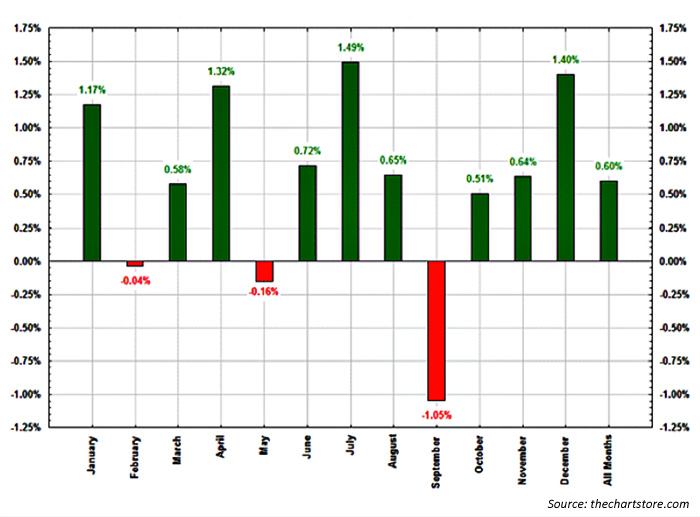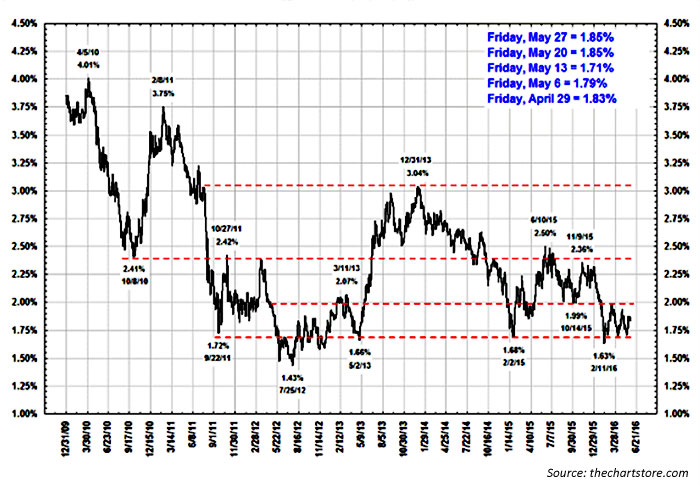
- The possible FOMC decision to raise interest rates this month or next. This has become much more difficult to predict given the extremely weak employment report on June 3.
- The “Brexit” vote on June 23. At this point, it is too close to call whether British citizens wish to continue membership in the European Union.
- The U.S. dollar, which gives clues for everything. It is important to note how the U.S. dollar’s strength has impacted corporate income.
- Gold and its role as a currency, a metal, and a hedge against inflation. When acting as a commodity, gold depreciates as the U.S. dollar rises. However, during any global currency disruptions, gold becomes the de facto safety-net currency. For those who are adventurous, buy gold using a weaker currency to take advantage of dollar strength.
One way to play defensive ball is via the options market. Buy put spreads on the S&P 500 futures, SPY, or NASDAQ, depending on the concentration of your portfolio (buy a higher strike and sell a lower strike to help offset some of the costs). For example, you could purchase the September 2030 puts on the S&P 500 for $44.50 and then sell the 2010 puts for $40.75; the cost would be $3.75 and offer you 20 points of S&P 500 downside protection. Alternatively, you could buy the 2030 puts for $44.50 and sell the 1990 puts for $36.50, giving you 40 points of downside protection for a cost of $8.00.
The amount of put spreads you should buy and sell depends on the size of the portfolio you are hedging. Support for the S&P 500 futures is at 2030.25. Below that the market will likely fall to 2019, then 2012. Below that level there will be a painful trip to 1992 and then 1967. The upside resistance level is at 2105.24. Above that level there is open space! Sell covered calls on stocks in your portfolio, making sure to capture any dividend that might be paid. I believe in selling naked puts on stocks that I want to own. I get paid while waiting to purchase the security I want at a lower price. Keep stops active.
September is historically the worst month of the year (see Exhibit 1), as investors often sell in fear of another market event in October. While this typically doesn’t happen, the freefalls of October 24, 1929, and October 19, 1987, have burned painful memories into the minds of investors. By the third week in October, the pressure is off and the market typically rallies. We have reason to believe this effect may be somewhat delayed this year. Why? The U.S. elections will bleed uncertainty into the markets. The markets hate uncertainty. Yet, no matter what the outcome, the reality is that nothing much will change. Remember that whatever is being promised by any candidate first has to be passed by Congress (and you know how that will go).
Exhibit 1—S&P 500 INDEX
Average one-month performance, 1928–2015

A potential FOMC rate hike, in plain English, means the FOMC believes the U.S. economy is doing well enough to absorb a rate hike, minimizing the negative effects of the increased cost of money. What we need to ask is, are the governors correct or are they misreading the economic data? I believe that a strong dollar, the short-term result of a rate hike, will continue to have a negative effect on corporate earnings and an overall deflationary effect. That, paired with the greater cost of borrowing money, could impact U.S. economic expansion.
That said, with the 10-year U.S. Treasury yield around 1.8% (see Exhibit 2) and the yield of the German bund just barely positive, where do you think global investments will flow? The market pressure produced by foreign funds chasing comparatively high U.S. rates will prevent any serious run up in U.S. interest rates. Unfortunately, global yield-seeking investments flowing into our country might prevent significant rate increases. The results of lower corporate profits due to the effects of a strong U.S. dollar will be reduced employment and reduced capital expenditures. This last point is, of course, with the exception of opportunities to reduce labor costs. Mergers and acquisitions should continue. Corporations remain interested in developing cost efficiencies by merging with companies that will bring value to the bottom line.
Exhibit 2—U.S. TREASURY YIELDS
10-year constant maturity

 Jeanette Schwarz Young, CFP, CMT, CFTe, is the author of the Option Queen Letter, a weekly newsletter issued and published every Sunday, and "The Options Doctor," published by John Wiley & Son in 2007. She was the first director of the CMT program for the CMT Association (formerly Market Technicians Association) and is currently a board member and the vice president of the Americas for the International Federation of Technical Analysts (IFTA). www.optnqueen.com
Jeanette Schwarz Young, CFP, CMT, CFTe, is the author of the Option Queen Letter, a weekly newsletter issued and published every Sunday, and "The Options Doctor," published by John Wiley & Son in 2007. She was the first director of the CMT program for the CMT Association (formerly Market Technicians Association) and is currently a board member and the vice president of the Americas for the International Federation of Technical Analysts (IFTA). www.optnqueen.com
